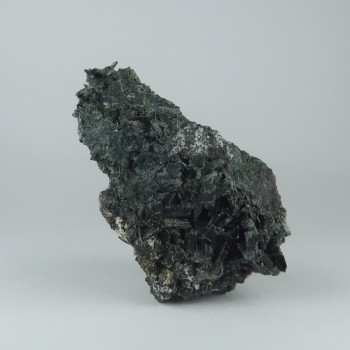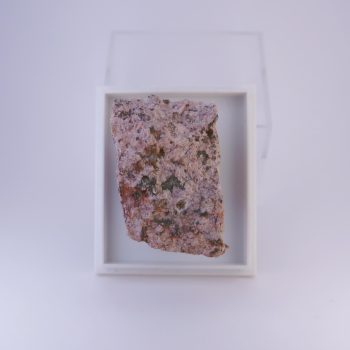Hedenbergite
Hedenbergite is the iron-rich end member of the pyroxene group. It is extremely uncommon to find naturally.
Showing all 2 results
-

Hedenbergite from Coto San Guillermo, Spain
Price range: £10.00 through £12.50 -

Hedenbergite from Loch Scridain area, Scotland
£35.00
Information about Hedenbergite
Hedenbergite is a dark green to black pyroxene mineral, often found as prismatic crystals or massive aggregates. The mineral’s color can vary from pale green to deep black, depending on its iron content, with higher iron concentrations resulting in darker hues.
Its crystals are typically short, stubby, and occasionally striated, exhibiting a monoclinic structure. Hedenbergite often forms in contact or regional metamorphic rocks, especially in skarns.
Uses and History
Hedenbergite is primarily valued by mineral collectors and researchers rather than for widespread industrial use. Its presence in skarn deposits provides important clues about the temperature and pressure conditions of formation, making it significant in geological studies.
In some cases, hedenbergite is used as a gemstone, though it is not common due to its relative softness and cleavage properties.It is more likely to be cut for stone collectors than ever used for jewellery.
Its association with valuable ore minerals like magnetite, chalcopyrite, and sphalerite also makes it important in mining geology, as it can act as an indicator of ore deposits.
Hedenbergite was first described in 1819 and named after Swedish mineralogist Ludwig Hedenberg, who contributed significantly to the study of minerals.
The mineral was discovered in Sweden, where it occurs in several notable skarn deposits. The type locality of Hedenbergite is Mormorsgruvan, Tunaberg Cu-Co Ore Field, Tunaberg, Nyköping, Södermanland County, Sweden.
Mineralogy
Green, brown-green, dark green, black
Hazards and Warnings
Mineral collectors should wash their hands after handling specimens, to avoid any exposure to potential toxins.
Almost all rocks, minerals (and, frankly, almost all other substances on earth) can produce toxic dust when cutting, which can cause serious respiratory conditions including silicosis.
When cutting or polishing rocks, minerals, shells, etc, all work should be done wet to minimise the dust, and a suitable respirator or extraction system should be used.
Translations
Arabic:
Hindi:
Portuguese:
Bengali:
Indonesian:
Punjabi:
English:
- Hedenbergite
Italian:
Russian:
French:
Japanese:
- 灰鉄輝石
Spanish:
- Hedenbergita
German:
- Hedenbergit
Korean:
Thai:
Gujurati:
Mandarin Chinese:
Urdu:
